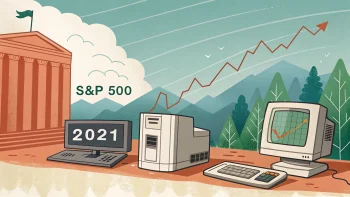In recent years, the investing world has witnessed a significant shift towards passive and index investing strategies, with more investors opting for low-cost, broad market exposure over active management. The S&P 500 Index, for instance, has delivered an impressive 11% annual return over the past five years.
However, recent data from JP Morgan suggests that the next five years could paint a very different picture, with annualized returns potentially falling to around 5%. This article analyzes the factors behind this challenging outlook and explores alternative investment opportunities for investors seeking to navigate this low-return environment.
Related: 15 Hacks That’ll Save You Money Over Amazon
View this post on Instagram
A post shared by Taylor Sohns- CFP®, CIMA®, MBA- Finance (@lifegoalinvestments)
Table of Contents
ToggleUnderstanding Valuations and Market Returns
The JP Morgan data mentioned in the Instagram reel’s transcription highlights an important relationship between market valuations and future returns. The graph compares two factors: the valuation of stocks on the x-axis, measured by whether they are cheap or expensive, and the S&P 500’s annualized returns for the next five years on the y-axis.
As illustrated in the graph, there is a clear inverse relationship between valuations and future returns. As stocks become more expensive, the subsequent five-year annualized returns tend to decrease. Currently, the valuation of the S&P 500 sits at the higher end of the scale (represented by the red dot), indicating that historical patterns suggest a more muted outlook for the index’s future performance.
The Implications for Passive and Index Investors
This data has significant implications for passive and index investors who rely on broad market exposure to generate returns. While the S&P 500 has been a reliable source of market-beating returns in recent years, the prospects of a lower-return environment call for renewed scrutiny of investment strategies and risk management.
It is crucial to note that this data does not suggest that investors should completely abandon passive and index investing. Instead, it highlights the importance of diversifying investment portfolios and seeking alternative sources of returns to complement traditional stock market exposure.
Alternative Investment Opportunities
For investors seeking to adapt their strategies to this changing landscape, several alternative investment opportunities could offer attractive return prospects with manageable risk. Some of these investment options include:
- Bond ETFs: The world of fixed income offers several opportunities for yield-seeking investors, with bond ETFs providing relatively high income and attractive risk-adjusted returns. Some bond ETFs currently pay over 8% yields, historically representing 60% less risk than the S&P 500.
- Farmland: Investing in agricultural land can serve as a hedge against inflation and provide a relatively stable income stream from lease payments or crop sales. Some farmland investments also offer potential capital appreciation through land productivity improvements and increasing global food demand.
- Infrastructure: Infrastructure investments—such as toll roads, ports, and renewable energy projects—can provide investors with long-term, stable cash flows that are less vulnerable to economic cycles. These investments may also benefit from government initiatives supporting infrastructure development.
- Private Real Estate: Private real estate investments in properties such as multi-family units, office buildings, or retail centers can offer attractive returns through rental income and potential capital appreciation. This sector allows investors to diversify away from mainstream stock markets while gaining exposure to the overall economy.
- Emerging Markets: As developed market valuations come under pressure, emerging markets could offer compelling return prospects for investors willing to take on additional risk. Some emerging economies exhibit strong growth potential, favorable demographics, and undervalued asset prices, which can fuel long-term portfolio growth.
Conclusion
The data suggesting reduced annualized returns for the S&P 500 over the next five years underscores the importance of diversification and portfolio adjustment for investors engaged in passive and index strategies. While embracing these alternative investments may require additional research and due diligence, the potential payoffs in the form of higher returns and risk mitigation can make them valuable components of a well-rounded investment approach. As the investing world evolves, proactive and adaptive investors will be best positioned to capitalize on strategic opportunities and safeguard their financial future.
Related: Top Financial Tools of 2023
FAQs (Frequently Asked Questions)
1. What is passive and index investing?
Passive and index investing strategies involve investing in funds or portfolios that aim to replicate the performance of a specific market index, such as the S&P 500, rather than actively selecting individual stocks. These strategies typically offer low-cost, broad market exposure.
2. Why has there been a shift towards passive and index investing?
The shift towards passive and index investing is driven by several factors, including lower fees, historical evidence of market outperformance, and the belief that it is challenging for active managers to beat the market over the long term consistently.
3. What does the data from JP Morgan suggest about future market returns?
According to JP Morgan data, future annualized returns for the S&P 500 are expected to decrease, potentially falling to around 5% over the next five years. This projection is based on the historical relationship between market valuations and future returns.
4. How are market valuations related to future returns?
There is an inverse relationship between market valuations and future returns. When stocks are expensive (high valuations), future returns tend to be lower, and vice versa. This relationship is essential for investors to consider when making investment decisions.
5. Should investors completely abandon passive and index investing in light of this data?
No, the data does not suggest the complete abandonment of passive and index investing. Instead, it emphasizes the need for diversification. While passive strategies can remain a core part of an investment portfolio, it’s wise to explore alternative sources of returns to reduce risk and enhance overall performance.
6. What are some alternative investment opportunities mentioned in the article?
The article suggests several alternative investments, including:
- Bond ETFs offer relatively high income and attractive risk-adjusted returns compared to stocks.
- Farmland: Investing in agricultural land can provide stability and potential capital appreciation.
- Infrastructure: Investments in toll roads, ports, and renewable energy projects can offer stable cash flows.
- Private Real Estate can yield returns through rental income and potential capital appreciation.
- Emerging Markets: These markets may offer compelling return prospects for investors willing to take on additional risk.
7. How can investors adapt to a changing investment landscape?
Investors should consider diversifying their portfolios by incorporating alternative investments alongside traditional passive and index strategies. Conducting thorough research and due diligence on these alternatives is essential to mitigate risk and potentially achieve higher returns.
8. Why is diversification important in the context of a low-return environment?
Diversification helps spread risk across different asset classes, reducing the impact of poor performance in any one area. It can enhance the potential for overall portfolio growth and income generation in a low-return environment.
9. How can investors stay proactive and adaptive in their investment approach?
Staying proactive involves regularly reviewing and adjusting your investment portfolio to align with changing market conditions. This might mean rebalancing assets, exploring new investment opportunities, and staying informed about evolving market trends.
10. What’s the key takeaway from the article?
The key takeaway is that, as the investment landscape evolves, investors should be open to diversification and exploring alternative investment opportunities to successfully navigate a potentially low-return environment. Staying proactive and adaptive in your approach can help safeguard your financial future.
Featured Image Credit: Photo by Andrew Neel; Pexels; Thank you!


















